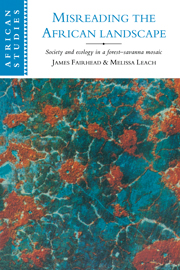Book contents
- Frontmatter
- Contents
- List of plates
- List of figures
- List of tables
- Note on authorship and research collaboration
- Acknowledgements
- Linguistic conventions
- Introduction
- 1 Convictions of forest loss in policy and ecological science
- 2 Forest gain: historical evidence of vegetation change
- 3 Settling a landscape: forest islands in regional social and political history
- 4 Ecology and society in a Kuranko village
- 5 Ecology and society in a Kissi village
- 6 Enriching a landscape: working with ecology and deflecting successions
- 7 Accounting for forest gain: local land use, regional political economy and demography
- 8 Reading forest history backwards: a century of environmental policy
- 9 Sustaining reversed histories: the continual production of views of forest loss
- 10 Towards a new forest–savanna ecology and history
- Appendix I Glossary of plant names
- Appendix II Cassette recordings of oral accounts and discussions
- Notes
- List of references
- Index
- Titles in the series
- Plate section
5 - Ecology and society in a Kissi village
Published online by Cambridge University Press: 05 June 2012
- Frontmatter
- Contents
- List of plates
- List of figures
- List of tables
- Note on authorship and research collaboration
- Acknowledgements
- Linguistic conventions
- Introduction
- 1 Convictions of forest loss in policy and ecological science
- 2 Forest gain: historical evidence of vegetation change
- 3 Settling a landscape: forest islands in regional social and political history
- 4 Ecology and society in a Kuranko village
- 5 Ecology and society in a Kissi village
- 6 Enriching a landscape: working with ecology and deflecting successions
- 7 Accounting for forest gain: local land use, regional political economy and demography
- 8 Reading forest history backwards: a century of environmental policy
- 9 Sustaining reversed histories: the continual production of views of forest loss
- 10 Towards a new forest–savanna ecology and history
- Appendix I Glossary of plant names
- Appendix II Cassette recordings of oral accounts and discussions
- Notes
- List of references
- Index
- Titles in the series
- Plate section
Summary
The truck rarely gets to Toly, the end of the road. Those from Kissidougou usually stop at the sub-prefecture headquarters at Koundiadou for the Monday market, going no further south-east. It is traders from there, on foot or bicycle, who bring produce to the small Wednesday market at Toly. From Koundiadou, it is a three-hour walk, the last half hour southwards through forest thicket vegetation very different from the savannas further north and west. Once the forest fallow gives way to the high forest of Toly's large forest island, there is still more than a kilometre to go before surmounting the vantage point from which the large, gently sloping village clearing opens out. Traders set up in front of the tiny village primary school, in the open space dividing the upper and lower parts of the village.
Each half of the village is a cluster of large, closely packed, rectangular metal-roofed houses and round thatched sleeping huts and kitchens. It is hard to infer from this layout that most buildings are loosely grouped into compounds (bεε) each associated with a particular patrilineage. Each has an elder who represents the patrilineage members, resident spouses and strangers (miallo) in village matters. Immediately behind the houses, the huge trees of the forest island (bundͻͻ) begin, shading coffee and fruit plantations except in those parts reserved for the affairs of the men's and women's power associations.
- Type
- Chapter
- Information
- Misreading the African LandscapeSociety and Ecology in a Forest-Savanna Mosaic, pp. 149 - 175Publisher: Cambridge University PressPrint publication year: 1996

